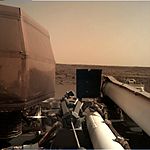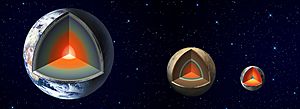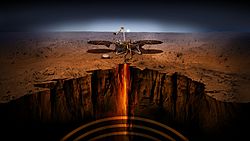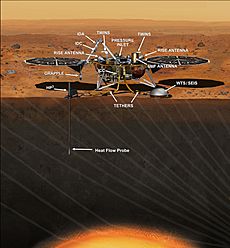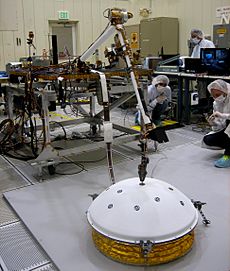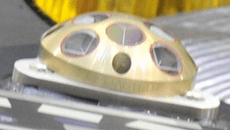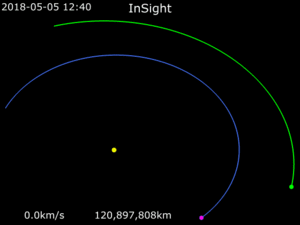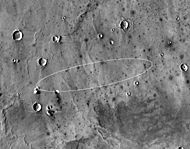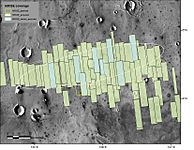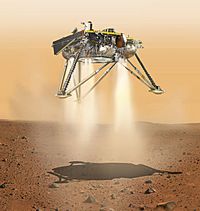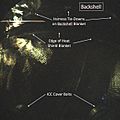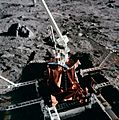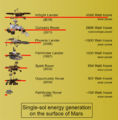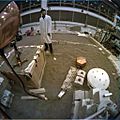InSight facts for kids
(This article is about the NASA InSight mission. Click here for the Insight that is the act of understanding the inner nature of things.)
 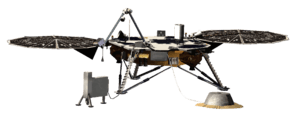
Top: Artist's rendering of the MarCO CubeSats
Bottom: Artist's rendering of the InSight lander |
|
| Names | Interior Exploration using Seismic Investigations, Geodesy and Heat Transport Geophysical Monitoring Station Discovery 12 |
|---|---|
| Mission type | Mars lander |
| Operator | NASA / JPL |
| Mission duration | Planned: 709 sols (728 days) Current: 1919 sols (1971 days) since landing |
| Spacecraft properties | |
| Launch mass | 694 kg (1,530 lb) |
| Landing mass | 358 kg (789 lb) |
| Dimensions | Deployed: 6.0 × 1.56 × 1.0 m (19.7 × 5.1 × 3.3 ft)- |
| Power | 600 W, solar / Li-ion battery |
| Start of mission | |
| Rocket | Atlas V 401 |
| Launch site | Vandenberg SLC-3E |
| Contractor | United Launch Alliance |
| Mars lander | |
| Landing date | 26 November 2018, 19:52:59 UTC |
| Landing site | Elysium Planitia 4°30′N 135°00′E / 4.5°N 135.0°E |
| Flyby of Mars | |
| Spacecraft component | Mars Cube One (MarCO) |
| Closest approach | 26 November 2018, 19:52:59 UTC |
| Distance | 3,500 km (2,200 mi) |
 |
|
The Interior Exploration using Seismic Investigations, Geodesy and Heat Transport (InSight) mission is a robotic lander designed to study the deep interior of the planet Mars. It was manufactured by Lockheed Martin and is managed by NASA's Jet Propulsion Laboratory. The mission launched on 5 May 2018 at 11:05 UTC aboard an Atlas V-401 rocket and successfully landed at Elysium Planitia on Mars on November 26, 2018, 19:52:59 UTC. InSight traveled 483 million km (300 million mi) during its journey.
InSight's objectives are to place a seismometer, called SEIS, on Mars's surface to measure seismic activity and provide accurate 3D models of the planet's interior; and measure internal heat flow using a heat probe called HP3 to study Mars's early geological evolution. This could bring a new understanding of the Solar System's terrestrial planets—Mercury, Venus, Earth, Mars—and Earth's Moon.
The lander was originally planned for launch in March 2016. Following a persistent vacuum failure in the SEIS instrument prior to launch, with the 2016 launch window missed, InSight was returned to Lockheed Martin's facility in Denver, Colorado, for storage. NASA officials decided in March 2016 to delay launching InSight to May 2018. This allowed time for the seismometer issue to be fixed, although it increased the cost from the previous US$675 million to a total of US$830 million. By reusing technology from the Mars Phoenix lander, which successfully landed on Mars in 2008, mission costs were reduced.
Contents
History
Lockheed Martin began construction of the lander on 19 May 2014, with general testing starting in 27 May 2015.
On 9 March 2016, NASA officials announced that InSight would be delayed until the 2018 launch window at an estimated cost of US$150 million. The spacecraft was rescheduled to launch on 5 May 2018 for a Mars landing on 26 November at 3 p.m.
On 22 November 2017 InSight completed testing in a thermal vacuum, also known as TVAC testing, where the spacecraft is put in simulated space conditions with reduced pressure and various thermal loads. On 23 January 2018, after a long storage, its solar panels were once again deployed and tested, and a second silicon chip containing 1.6 million names from the public was added to the lander.
On 28 February 2018, InSight was shipped via C-17 cargo aircraft from the Lockheed Martin Space Systems building in Denver to the Vandenberg Air Force Base in California in order to be integrated to the launch vehicle.
The lander was launched on 5 May 2018 and arrived on Mars at approximately 19:54 UTC on 26 November 2018.
Mission status
On 26 November 2018, NASA reported that the InSight lander had landed successfully on Mars. A touchdown image was received, taken through a transparent lens cover. NASA reported that the cover, along with the cover on another camera, would be removed within the next few days.
A few hours later, at about 1:30 UTC (8:30 p.m. EST), NASA's Mars Odyssey orbiter relayed signals indicating that InSight's solar panels successfully unfurled and are generating electrical power. Enough power is being generated to recharge its batteries daily. Odyssey also relayed a pair of images showing InSight's landing site. More images will be taken in stereo pairs to create 3D images, allowing InSight to find the best places to put the heat probe and seismometer. Over the next few weeks, InSight will check health indicators and monitor both weather and temperature conditions at the landing site.
The meteorological suite (TWINS) and magnetometer are operational, but science does not fully begin for ten weeks after landing, and the mission will take up to three months to deploy and commission the geophysical science instruments.
Objectives
The InSight mission placed a single stationary lander on Mars to study its deep interior and address a fundamental issue of planetary and Solar System science: understanding the processes that shaped the rocky planets of the inner Solar System (including Earth) more than four billion years ago.
InSight's primary objective is to study the earliest evolutionary history of the processes that shaped Mars. By studying the size, thickness, density and overall structure of Mars' core, mantle and crust, as well as the rate at which heat escapes from the planet's interior, InSight will provide a glimpse into the evolutionary processes of all of the rocky planets in the inner Solar System.
The mission will determine if there is any seismic activity, measure the rate of heat flow from the interior, estimate the size of Mars' core and whether the core is liquid or solid.
After landing, the mission will take three months to deploy and commission the science instruments. It will then begin its mission of observing Mars, which is expected to last for two years.
Payload
InSight's payload has a total mass of 50 kg, including science instruments and support systems such as the Auxiliary Payload Sensor Suite, cameras, the instrument deployment system, and a laser retroreflector. The science payload consists of two main instruments, SEIS and HP3:
- The Seismic Experiment for Interior Structure (SEIS) will take precise measurements of marsquakes and other internal activity on Mars to better understand the planet's history and structure. It will also investigate how the Martian crust and mantle respond to the effects of meteorite impacts, which gives clues to the planet's inner structure.
- The Heat Flow and Physical Properties Package (HP3), provided by the German Aerospace Center (DLR), is a self-penetrating heat flow probe. Referred to as a "self-hammering nail" and nicknamed "the mole", it was designed to burrow as deep as 5 m (16 ft) below the Martian surface while trailing a tether with embedded heat sensors to measure how efficiently heat flows through Mars' core, and thus reveal unique information about the planet's interior and how it has evolved over time.
- The Rotation and Interior Structure Experiment (RISE) led by the Jet Propulsion Laboratory (JPL), is a radio science experiment that will use the lander's X band radio to provide precise measurements of planetary rotation to better understand the interior of Mars.
- Temperature and Winds for InSight (TWINS), fabricated by Spain's Centro de Astrobiología, will monitor weather at the landing site.
- Laser RetroReflector for InSight (LaRRI) is a corner cube retroreflector provided by the Italian Space Agency and mounted on InSight's top deck. It will enable passive laser range-finding by orbiters even after the lander is retired, and would function as a node in a proposed Mars geophysical network.
- Instrument Deployment Arm (IDA) is a 2.4 m robotic arm that will be used to deploy the SEIS and HP3 instruments to Mars' surface. It also features the IDC camera.
- The Instrument Deployment Camera (IDC) is a color camera based on the Mars Exploration Rover and Mars Science Laboratory navcam design. It is mounted on the Instrument Deployment Arm and will image the instruments on the lander's deck and provide stereoscopic views of the terrain surrounding the landing site.
Launch

The spacecraft was launched on 5 May 2018 at 11:05 UTC on an Atlas V 401 launch vehicle (AV-078) from Vandenberg Air Force Base Space Launch Complex 3-East. This was the first American interplanetary mission to launch from California.
The launch was managed by NASA's Launch Services Program. InSight was originally scheduled for launch on 4 March 2016 on an Atlas V 401 (4 meter fairing/zero (0) solid rocket boosters/single (1) engine Centaur) from Vandenberg Air Force Base in California, U.S., but was called off in December 2015 due to a vacuum leak on the SEIS instrument. The rescheduled launch window ran from 5 May to 8 June 2018.
The journey to Mars took 6.5 months across 484 million km (301 million mi) for a touchdown on 26 November. Landing successfully, a three-month-long deployment phase commenced as part of its two-year (about one Martian year) prime mission.
Landing site
It is located in western Elysium Planitia at 4°30′N 135°54′E / 4.5°N 135.9°E. The landing site is about 600 km (370 mi) north from where the Curiosity rover is operating in Gale Crater.
Landing
On 26 November 2018, at approximately 19:53 UTC, mission controllers received a signal via the Mars Cube One (MarCO) satellites that the spacecraft had successfully touched down at Elysium Planitia. After landing, the mission will take three months to deploy and commission the geophysical science instruments. It will then begin its mission of observing Mars, which is planned to last for two years.
CubeSats
The Mars Cube One (MarCO) spacecraft are a pair of 6U CubeSats that piggybacked with the InSight mission to test CubeSat navigation and endurance in deep space, and to help relay real-time communications (eight minute delay) during the probe's entry, descent and landing (EDL) phase.
Team and participation
The InSight science and engineering team includes scientists and engineers from many disciplines, countries and organizations. The science team assigned to InSight includes scientists from institutions in the U.S., France, Germany, Austria, Belgium, Canada, Japan, Switzerland, Spain, Poland and the United Kingdom.
Major contributing agencies and institutions:
National agencies:
- National Aeronautics and Space Administration (NASA)
- Centre National d'Études Spatiales (CNES)
- Deutsches Zentrum für Luft- und Raumfahrt (DLR)
- Italian Space Agency (ASI)
Contributing institutions:
- Jet Propulsion Laboratory (NASA/JPL)
- Lockheed Martin
- Institut de Physique du Globe de Paris (IPGP)
- Swiss Federal Institute of Technology in Zurich (ETHZ)
- Max Planck Institute for Solar System Research (MPS)
- Imperial College London
- Institut supérieur de l'aéronautique et de l'espace (ISAE-SUPAERO)
- University of Oxford
- Centrum Badań Kosmicznych (CBK)
Gallery
Images for kids
-
The InSight Lander as viewed from the MRO (23 September 2019).
-
Actor Brad Pitt visits the InSight test "sandbox" (September 2019).
See also
 In Spanish: InSight para niños
In Spanish: InSight para niños




